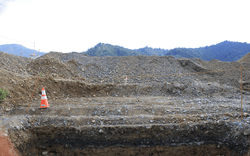




Yung Ho Chang oral history, from Wang Tuo, Intensity in Ten Cities (2025), co-commissioned by the CCA and M+, Hong Kong for How Modern: Biographies of Architecture in China 1949–1979. © Wang Tuo
Launching the State Architect
Yung Ho Chang in conversation with Shirley Surya and Li Hua about Zhang Kaiji
- Shirley Surya and Li Hua
- What did your father, Zhang Kaiji, do before he came to Beijing? What was his architecture training?
- Yung Ho Chang
- He was born in Shanghai and went back for high school. Then, during World War II, he worked for a big office in Nanjing. My father was short-tempered, so he probably didn’t get along that well with the people in the office there and was sent to Chongqing to lead a branch of the firm. He was perhaps twenty-five, only a short time out of school, but already an architect-in-charge, and he had designed a high school in Chongqing. That’s where he experienced the war.
After the war, my father came back to Shanghai to start his private practice. At that time, it wasn’t easy to get a job, although he had at least a couple of decent projects, including some private houses in Shanghai and dormitories in Nanjing.
- SS & LH
- Can you share anything about his decision to stay and rebuild Beijing in the first decade after the founding of the People’s Republic of China?
- YHC
- He stayed in Beijing to join that big company [BIAD], which he did for two significant reasons. One is that he was guaranteed some projects. He and his partners were struggling in private practice. I recall that, at one point, they had three people in the firm and decided to split up due to a lack of work. And then, of course, my father rightfully sensed that he could secure larger commissions from the new government. And he did receive some of the most important commissions possible at the time, like the Military Museum of the Chinese People’s Revolution and the Beijing Planetarium, among others. He never said if an independent or private practice in China was the best option for him. But he later expressed that if he could have left China, like his good friend I.M. Pei, he could have been more successful elsewhere, like in Hong Kong or the United States.
The Beijing Yongmao Architectural Design Company’s recruitment process required applicants such as Zhang Kaiji to submit their curriculum vitae to the municipal construction bureau to receive a license based on their academic qualifications. Only those with the title of “engineer” or “deputy engineer” could be formally assigned to design tasks. Zhang Kaiji’s Professional Manual for Architects and Civil Engineers in Beijing, 1951. © Yung Ho Chang
Letter from Liang Sicheng to Zhang Kaiji, 1949. © Yung Ho Chang
Dear Mr. Kaiji,
I have received your letter dated 30 October and understand that you wish to urgently resolve the issue of where you will work in the future. Currently, Beijing is undergoing extensive development, and what is needed the most are architects. The state-owned North China Construction Company (a corporation) is currently seeking experienced architects. At the same time, the soon-to-be-reorganized planning office for the Beijing Urban Planning Commission, which will be responsible for most of the architectural design work for various central government ministries, will also need many architects. Your service is therefore highly sought after from multiple sides. The establishment of the planning office will take at least ten more days, possibly until the end of the year. This is an initiative under my direct leadership, so if you are willing to collaborate with me on this work, I would be more than delighted. However, if you wish to make a decision more urgently, I can also recommend you to the North China Construction Company. The company will also be working closely with the Urban Planning Commission, but it is considered a different work unit. Once you have received this letter, I hope that you can come to Beijing to discuss this further. Please call me first once you arrive to arrange a meeting time.
This is a dedicated reply, copied to the relevant authorities.
Respectfully, Liang Sicheng
3 December 1949
Translated from Chinese by Yilin Wang
- SS & LH
- Even so, his projects in Beijing are all key buildings. Do you know how he felt about them?
- YHC
- I don’t know if my father wanted to design, say, modern architecture. I don’t know if he cared much about that. He was more of a typical Beaux-Arts architect, capable of working in different styles. Most of the Chinese state architects were like that and had no strong ideological inclination, one way or another.
During the late 1970s and early 1980s, he still had clients coming to him. I asked him, “How’s it going with the design?” He would say, “Ah, it’s not very good.” So, I encouraged him by pointing out that there were still opportunities and interest in his design work. And then he said, “That’s not really my ambition.” I was so surprised—I thought he just wanted to be an architect. I asked him what he would prefer to do, and he responded that he wanted to be an ambassador, a diplomat. That was the first time my father spoke out about his true career interests.
Some literary figures shared my dad’s ambition. They knew each other because they were all writing for this literary journal in Shanghai. Of course, my father never used his real name. He had a variety of pen names. He didn’t want to expose himself as an architect, for some reason, but then he also didn’t get his honoraria for writing the pieces.
He also wrote over a hundred short articles for the Beijing Evening News. The points he made in these were quite radical for the time. He questioned the use of private cars and thought deeply about high-rise buildings in Beijing, among other things. I think he wanted to use his professional knowledge as an architect to have more of an impact on a societal level, rather than just designing buildings for a small group of people.
- SS & LH
- We would like to pick up on what you said about your father’s training in the Beaux-Arts style, so he wasn’t particularly loyal to one tradition. Did he ever share anything with you about the “big roof” aesthetic that dominated in the late 1950s?
- YHC
- I see the big roof as a design option among many; I wouldn’t mind making a big roof, but in my way, not just as a repeat of what’s been done in the past, whether on the buildings from the 1950s or during the big roof revival in the 1990s. I’m bringing this up because my father wanted the freedom to try out different things, but he was given the big roof as a standard design model. He didn’t like that. And, especially for the Sanlihe Government Office, the design was so indecisive: big roof, no big roof. The whole project was so political, and architecture was at the mercy of the political struggles of the period.
He became entangled in numerous projects of this nature, which now seem like nonsensical events. A traditional Chinese building would not usually rise more than two stories, so there was a correct proportion of the big roof to the body of the building. He couldn’t imagine designing, say, a six-story building with a big roof, like Sanlihe. Still, he had to design it so that people could understand the traditional principles of Chinese architecture without sacrificing the proper relationship between the roof and the body of the building or repeating the style of gate houses.
In some cases, especially in the projects from the 1990s, the big roof always looked odd because architects didn’t want to use it—they didn’t want the hat. They would have preferred to design a modern building, but, of course, the hat had to be added to it. They undermined their designs by failing to address the issue of tradition proactively.
- SS & LH
- From your perspective, what project was the most meaningful to your father and why?
- YHC
- I don’t know; I suspect probably the Beijing Planetarium. This is more of a speculation on my part, based on my father’s taste and background. I am very much like him in this respect. He was dedicated to the visual arts. For this project, he collaborated with sculptors and painters of the Central Academy of Fine Arts as well as with students and professors to design the ceiling, mural, and reliefs on the façade. I think he had a good time working with East German structural engineers to design the dome’s structure.
- SS & LH
- In an early essay of yours, you stated that there was no modern architecture in China before the Reform and Opening Up policy in 1979. Do you still feel the same?
- YHC
- If I said that, I now realize that it probably wasn’t true. However, the common understanding that there was little modern architecture in China before the 1980s stemmed from the fact that Beijing was the centre for everything, architecture and otherwise, before then. There’s very little modern architecture in Beijing, but there was some, like the Peace Hotel. However, in bigger cities with colonial histories, such as Shanghai, there are classical buildings, Art Deco buildings, buildings with different surface techniques, like sculpted rock or pebble ash to simulate stone. Even if they aren’t modern in a European or American sense, they are nicely done.
- SS & LH
- But this definition of modern is based on style and technique, rather than a conception of modernity in a broader sense.
- YHC
- That was what was lacking in the Chinese architectural profession before the Reform. It wasn’t very intellectual at the time. This doesn’t mean that some architects wouldn’t have had these questions. But their education and practice at the time were very hands-on and practical, fairly straightforward. China has since changed a great deal, but it’s still like that in a way, especially compared to a city like Hong Kong. There’s still a resistance to a more thoughtful understanding of design, instead of just focusing on maximizing Floor Area Ratio and using expensive materials to make a building look prettier. This mentality is still predominant.
















